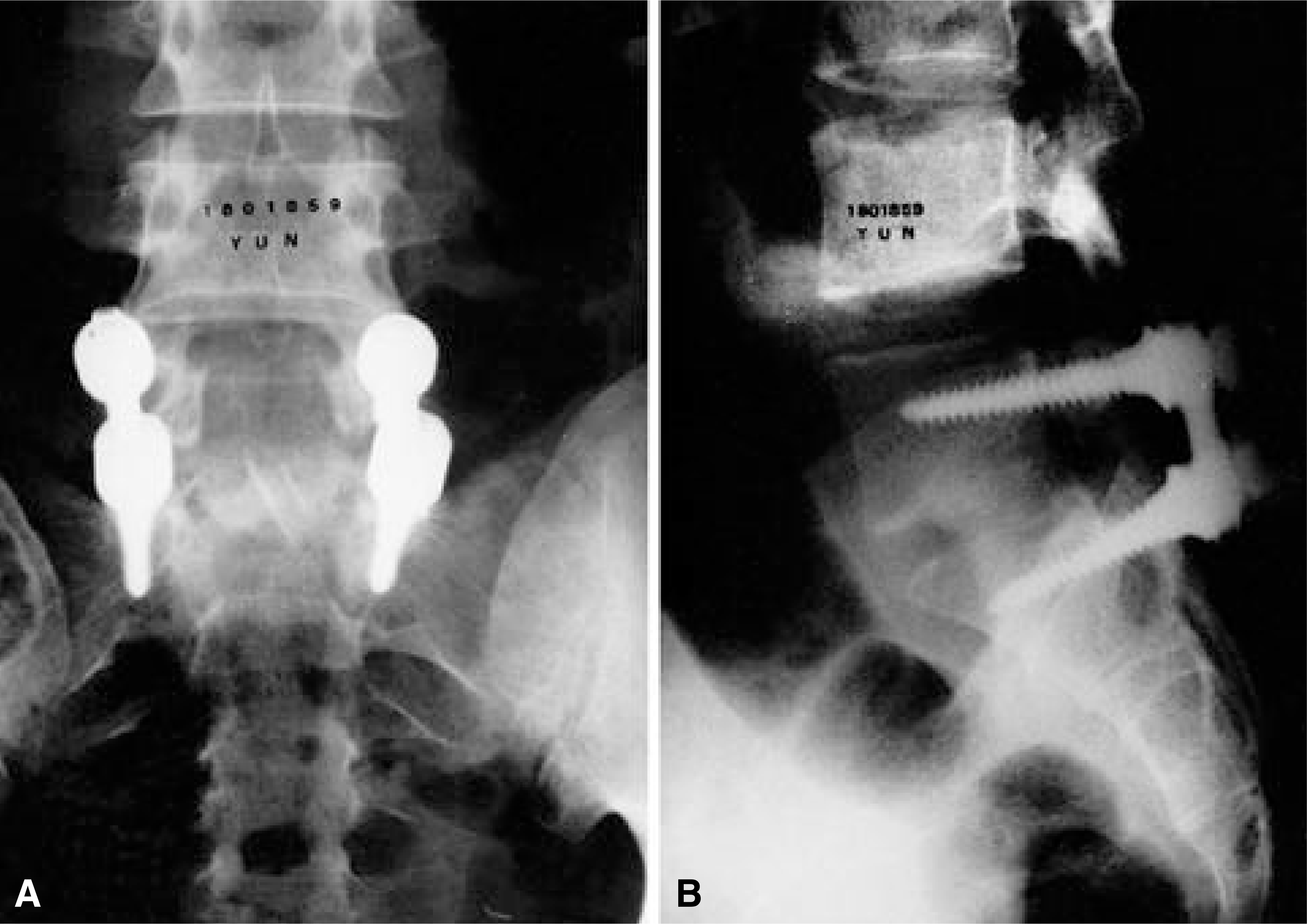Abstract
Study Design
This study reviewed prospectively 15 patients with chronic persistent low back pain who were treated with disc excision and posterior lumbar interbody fusion(PLIF). Outcomes of treatment were evaluated by a follow- up interview and x-ray studies.
Objectives
To evaluate the efficacy of surgical treatment of patients with chronic persistent low back pain resulting from internal disc derangement (IDD) that does not respond to conservative treatments.
Summary of Literature Review
Chronic persistent low back pain resisting to all known modalities of conservative treatments represents a difficult problem. The efficacy of any specific treatment methods for this group of patients is controversial.
Materials and Methods
Between 1994 and 2000, 15 patients were treated with disc excision and PLIF at Keimyung University Hospital from 1994 to 2000. The clinical outcomes were evaluated by postoperative follow- up interviews, and the fusion results were evaluated by x-ray studies.
Results
All patients responded properly to the follow- up evaluation. 66.6% of the patients had satisfactory results(13.3% excellent, 53.3% good, 26.7% fair, 6.7% poor), and a successful fusion was obtained in all of the patients. Conclusion : These results suggest that disc excision and PLIF for IDD patients is effective modality in treatment of IDD.
Go to : 
REFERENCES
1). Bogduk N, Tynan W, Wilson AS. The nerve supply to the human lumbar intervertebral discs. J Anat. 132:29–36. 1981.
2). Brown FW. Management of discogenic pain using epidural and intrathecal steroids. Clin Orthop. 129:72–78. 1977.
3). Chow SP, Leong JCY, Ma A, Yay A. Anterior spinal fusion for deranged lumbar intravertebral disc a review of 97 cases. Spine. 5:452–458. 1980.
4). Collis JS. Total disc replacement: A modified posterior lumbar interbody fusion. Clin Orthop. 193:64–67. 1985.
6). Crock HV. Internal disc disruption. A challenge to disc prolapse fifty years on. Spine. 11:650–653. 1986.
7). Fujimaki A, Crock HV. The results of 150 anterior lumbar interbody fusion operations performed by two surgeons in Australia. Clin Orthop. 165:164–167. 1982.

8). Hanley EN, Shapiro DE. The development of low back pain after excision of a lumbar disc. J Bone Joint Surg. 71:719–721. 1989.
9). Kim ID, Ihn JC, Park BC, and Ahn HS. The effect of epidural steroid injection in low back pain. J Korean Spine Surg. 1:81–86. 1994.
11). Lee CK, Vessa P, Lee JK. Chronic disabling low back pain syndrome caused by internal disc derangements. Spine. 20:356–361. 1995.

13). Lin PM, Cautini RA, Joyce MF. Posterior lumbar interbody fusion. Clin Orthop. 180:154–168. 1983.

14). Mooney V. Where is the pain coming from? Spine. 12:754–759. 1987.
15). Neil A. Schechter, Matthew P. France, Casey K. Lee. Painful internal disc derangements of the lumbosacral spine: Discographic diagnosis and treatment by posterior lumbar interbody fusion. Orthopedics. 14:447–451. 1991.
16). Rolander SD. Motion of the spine with special reference to stabilizing effect of posterior fusion. Acta Orthop Scan Suppl. 90:1–144. 1966.
17). Spangfort EV. The lumbar disc herniation. A computer-aided analysis of 2504 operations. Acta Orthop Scan Suppl. 142:1972.

18). Weinstein J, Claverie W, Gibson S. The pain of discog -raphy. Spine. 13:1344–1348. 1988.
19). Yoshizawa H, O'Brien JP, Smith WT, et al. N euro pathology of intervertebral disc removed for low back pain. J Pathol. 132:95–104. 1980.
20). Yune SH, Lee JK, Lee KB, and Kim KT. Disc excision and anterior lumbar interbody fusion for internal disc derangement at the lumbar and lumbosacral intervertebral space. J of Korean Orthop Assoc. 28:2414–2420. 1993.
Go to : 
 | Fig. 1A-B.This simple x-ray shows posterior lumbar interbody fusion and posterior instrumentation on L5-S1 level.(A: anteroposter-ial view. B: lateral view) |
Table 1.
Neil's criteria for clinical evaluation of surgical outcome




 PDF
PDF ePub
ePub Citation
Citation Print
Print


 XML Download
XML Download